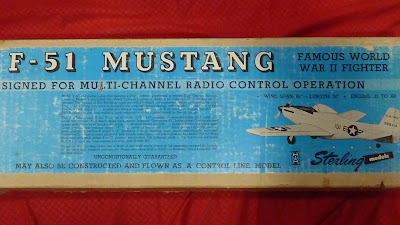I scored this kit on E-bay. I think the planets lined up for this one ( The "buy it now" price was the equivalent to $34 in 1976 ). It amazes me how many of these old kits are still laying around. Now, I just need a Gold Edition razorback to go with it. Of course, it will have flaps, retracts and a four-stroke.
The prototype of this model competed in the 1974 NATS and finished 2nd, behind Dave Platt and his Fw-190D in the standoff scale catagory. What a fun rivalry that must have been.
I'm having a hard time choosing a colour scheme. Here are the choices,
1. "Oh Johnnie", flown by Raymond Knight in Italy. The only P-47 pilot to receive the medal of honor in the European theatre. The other was Neel Kearby, in the Pacific.
2. "The Irish Shillalah", flown by James Finnegan. He caused Adolf Galland to crash land his Me-262. They met after the war.
3. The default kit markings of Glen Eagleston, even though he scored all his victories in the P-51.
4. A Russian example, in honor of Alexander Kartveli and Alexander de Seversky
5. A Chinese example, pg 183 of Bodie's book.
6. Francis Gabreski, the 56th Fighter Group was the first to fly the P-47 and they never traded them for P-51s.
What are the chances of finding 5 more kits? haha
Looking at the plans,
The wing seems to have a reasonably accurate outline, with root chord of 14" at the centerline and half span of 30". Aileron movement is shown as 3/8" up and down ( 8.5° ) at cross section C-C. This seems ideal to give a realistic roll rate. I would program this as the low rate at 60%. The real airplane had differential ailerons, deflecting 16° up ( approx 11/16" ) and 12° down ( approx 1/2" ) , or 14° average. The flaps should have a travel of 40°. Installing retracts is left up to the builder. For accuracy, the gear was angled back in plan view by about 12° and also angled forward in side view by the same amount.
Machine gun barrel sleeves can be made from 1/4" OD aluminum tubing or dowels, spaced 3/4" apart and staggered by about the same amount ( or 25/32" if you want to get picky ).
Machine gun barrel sleeves can be made from 1/4" OD aluminum tubing or dowels, spaced 3/4" apart and staggered by about the same amount ( or 25/32" if you want to get picky ).

The canopy is too large and needs to be cut down some. For reference, the aft part of the canopy was 62" long on the real plane and should be 7-3/4" on the model. I measured over 9". Correct sized wheels for 1/8 scale would be 4-1/4" for mains and 1-3/4" for tail.
Build and flight videos to follow on YouTube.






























